Recoiling from the sun like a cave skink, this 1957 Citroën Seidlitz Special crawled out of a dark garage into the harsh daylight of the Internet, looking for a new owner. The presumably one-off racer saw some laps in the late 1950s at Riverside and Pomona (California) road courses, as documented in My2CV. Now the interesting aluminum-bodied dart finds itself with the end tables and once-worn Prom dresses of Facebook Marketplace where it can be yours for the singular price of $111,111,111. In truth the price is apparently “highest offer over $35,000.” The posted price must be a way to weed out tire kickers. I mean, if you’re not willing to pay $111 million for a vintage race car, how can we take you seriously?
Put this sucker on the end of a stick and your yard will be free of weeds in no time! Joking aside, the 425 cc air-cooled flat-twin comes from the quintessentialy French Citroën 2CV which you may remember from popular movies including being cast as the Richard Drefuss’ “Tin Snail” in American Graffiti. The 425 made 12.5 HP in stock form, according to Wikipedia. This dual-carb version would have certainly produced at least 15 HP, which would have called for a sturdy rear bumper in the days when V8 Corvettes careened about California tracks on bias-ply tires.
The flowing lines of this lightweight flying French Fry recall Jaguar and Ferrari racers of the day, with every ounce of those high-dollar cars’ elegance. Shaping aluminum into curved panels is not for the meek. Even today, forming aluminum proves daunting compared to steel. The graceful lake pipes dump spent vapors just behind the driver’s air intake.
With upholstery worthy of an A+ in Home Ec and a steering wheel that’s the pride of Metal Fab, the Seidlitz Special wears High School technology throughout the cockpit, a sharp contrast with the aerodynamic body’s bespoke coachwork.
This artist’s rendering celebrates the Franco-American wonder, a marriage of lightweight engine and body that couldn’t differ more from American cars of the time. Despite poking some fun at the little mite, I’d love to see it lovingly refurbished or restored to its 1957 glory, and only in a way that guarantees it some track time on the California curves again. Nothing this purpose-built should be kept on a shelf. Have you seen a more beautiful ’50s sports car?
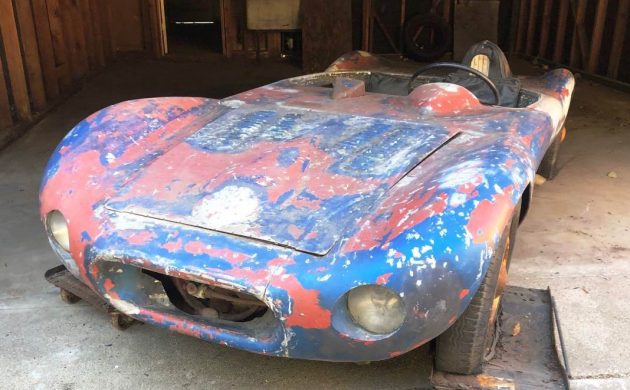
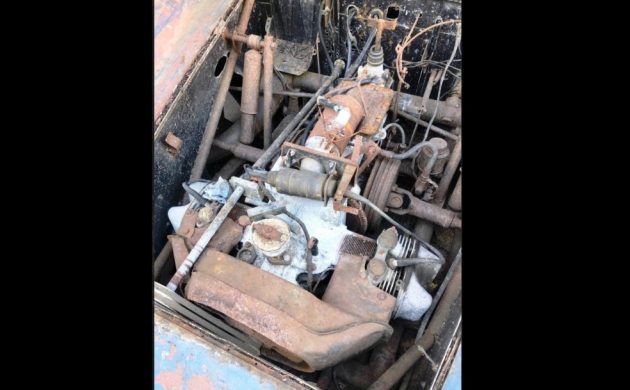
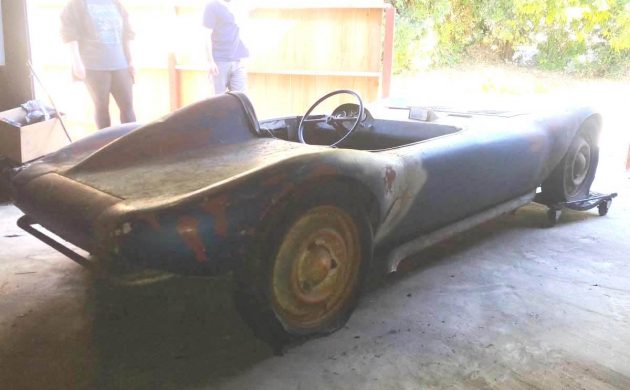
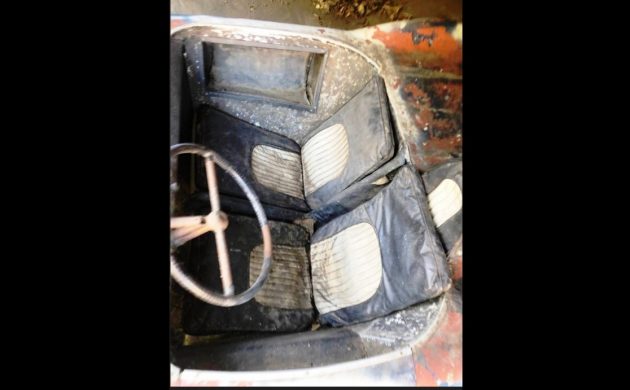
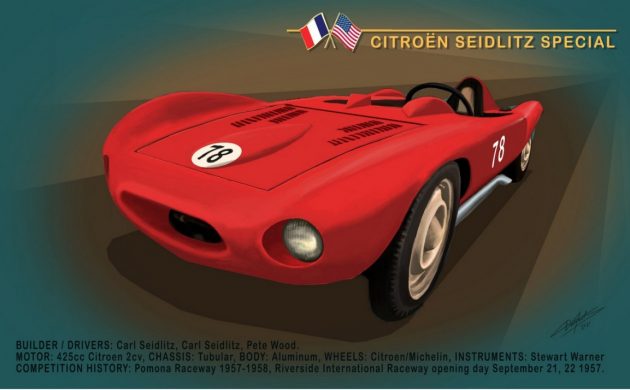



Cool find. It’s gorgeous. I really want to scream “Go Speed Racer, Go!” but 15hp? Even with aluminum, what would the top speed have been with one of these Todd?
MattR – top speed of the 2CV was about 60 MPH in those days. Even with optimum gears it’s hard to imagine more than 80 MPH in a long straight. Lightweight sports cars were known to frustrate the big heavy V8s in those days, but I’d venture those were nearer to 100 HP. Maybe someone with first-hand experience could chime in!
Thanks Todd. That would still be a good time at 60 mph in the twists.
The Tryane, a wooden trike designed and built by Friend Wood (assisted on the aerodynamic front by one Frank Costin) could brel the 100 m.p.h. barrier with the 605cc flat twin.
And so, probably, could this little jewel with some tuning and a five speed box.
Don’t know about 425s, but you can get just shy of 100mph at the end of Snetterton’s back straight out of a race-prepped 602.
Depends on wind direction, obviously!
Even faster if you stick a BMW 1100 oilhead in it…
Man, that is one sweet car – nice one, Todd!
As Rick Harrison would say, I’ll give you $55,555,555.50 and I’m not going to do no more.”
I would imagine the 2-cycle smoke screen helped with trying to outrun the competition on the strait aways…
BlondeUXB, these are NOT ringadings. The 2CV engine has rollerbearing rods, is a true HEMI 4 stroke and always has been, is the ONLY engine I’ve ever seen that has, get this: oil-cooled exhaust valve guides – a groove is machined into the side of the guide, which gets oil from a drilled channel to the groove to carry away excess heat, which is why you can run these engines flat out all day long and not hurt them – how’s that for genius?
Never sneer at one of these engines – this engine stayed in production for 40 yrs – can you name another engine that long-lived in the nearly original design? Oh, and it has rollerbearing conrods.
Further, to avoid problems common when it was designed around 1939, it has NO head gasket – just a precisely machined stepjoint between head and cylinders, so there can never be a headgasket failure. And very likely more of these flat twin engines have driven around the world than any other ride. So these engines are in a way, world renowned for durability and not smoking.
Ken Nelson,
Did you know the Tatra V8 engines [also air cooled] didn’t use head gaskets, the 2 circular surfaces are tapered for the best fit. [I’ve had a couple of them]
early Bugatti’s didnt have head gaskets
The 2CV engine was a 4-cycle engine. Would produce a smoke screen only if the rings are toast.
My error. Thanks for the correction/education…
//;-)
Recoiling from the sun like a cave skink… and it only got better 🤣. Best laugh I’ve had all week! Thanks Todd!
…flying French Fry is right up there also.
I dare say, I would put in a 4 cyl Honda 750 motorcycle engine with fuel injection.
Somebody please save this..a slightly hopped up”Big 6″ 2 CV motor..what a lovely car to cruise around in IMHO!!
a modern 600cc japaneese motorcycle motor in this would be a lot of fun for someone…but 35k?…a little rich for my blood…….
Nah, cram a small block V8 in the trunk, hook it up to a 5 speed and slide a lawn mower engine under the hood and let it run without a muffler. Then go out and challenge some Detroit iron to race for titles. Should be able to collect enough resellable American junk to pay for the purchase and refurb…… and, no, I would never let anyone look in the trunk. Under the hood, sure, but only a peek and no touching allowed.
Another Hayabusa swap candidate.
You hop that thing up any and you would snap off those 3 lug wheels. I would love to try it though.
The strange bit about this car is that, being based on the Panhard suspension supposedly, it’s a mystery to me why the Panhard engine wasn’t used instead of the 2CV. Any Panhard engine from about 1953 to the last cars made in ’67 put out 40 hp from 850 ccs. Maybe this one ran in a low cc class?
Many Panhard engines were raced – in Devin Panhards owned by Tony Rodriguez of Chico Ca. and his father, before Tony passed away too young.
Tony’s shop in Chico had a photo on the wall of his Devin Panhard in front of a 12 cylinder Maserati at Laguna Seca – the Maser could not pass that car, as the Panhard was so fast thru the corners he’d leave the M behind, and it couldn’t catch up with Tony’s car even in the straights he had such a lead. Two cylinders ahead of 12!! Reason? That Panhard engine is a full rollerbearing design, capable of 7000 rpm when designed in 1947. It also is a pure HEMI, and Tony along with Don Racine, of Mini Mania, had both boosted the Panhard flat twin to 80-90 hp – with 13:1 compression ratio – how’s that for wild??
So all I can figure is that, with already a Panhard chassis, why the 2CV engine instead of the Panhard 850 cc?
From looking at the limited photos provided, it appears that the suspension is standard 2CV. My guess is that the chassis is probably 2CV with tubular structure added to support the body.
By the way fellas, check out the Riverside race results in 1957 – two Panhards took 2nd & 3rd in one race, then 4 & 5 position in the next race on that site. Just goes to show how potent those little flat twins were and still are, if you have one, and the 2cv held its own with half the HP. Light cars, low CG, good roadholding – and still in Europe, the 2CV is used in all sorts of races – offroad, 4wd, you name it.
transplant a Subaru WRX and 5 or 6 speed in it for giggles and grins
If this was my car and I had a lot of time & a bit of money to invest, I would scrap the original drive train [but keep it all for future owners to convert it back to original], and install a similar, but far more potent drive train:
I would install a Panhard Dyna Z drive train up front. It’s still an air cooled opposed 2 cylinder 4-stroke motor with a 4-speed gearbox with front drive, also a vastly superior power curve of this high-revving 851cc, with a factory HP rate of up to 50hp. Panhard Dyna Z cars in stock form were capable of speeds up to 100MPH, in a 4-door sedan.
I would love to see what this car could do in this form! It could have given the Deutsche-Bonnet racers a challenge, especially at the 12 hour Sebring race where the D-B car won twice, the LeMans 3 times, and the Mille-Miglia 4 times. [In their class.]
I would love to hear from any buyer if they were considering this type of change.
Bill, my ’66 Panhard 24BT in Mich. has the last engine improvement – 60 hp in same basic configuration – and that engine would be the one to put in this car. If I’d been able to buy it, I’d also have installed the supercharger I picked up some yrs ago – now that wouldve been a helluva lot fun. But I decided just to install the spare race motor I bought from Tony Rodriguez’ estate to put in my ’65 DB Lemans roadster back in Detroit. With the 80 hp Tony claimed it put out, that car will fly.
Ken,
We can only dream! But what a race car it could have been!
I found a complete [1954?] Panhard Dyna Z about 10 years ago in the Washington DC area, it was silver or white, can’t remember. Was for sale cheap [like $500], but I had no room in the barn or garage. Do you happen to know if it was saved? The owner of the lot was going to scrap it for aluminum value. [My email is [email protected]]
Stunning. Give it to someone who knows what they are doing, put your own VW bones and engine underneath it, do the interior properly and go have a great time.
I tried to buy this car when it first appeared on FB Marketplace. The blurry barn find pics stirred up a lot of interest, and offers quickly came in. These bids were sight-unseen as the car wasn’t being shown to anyone. None of the offers were accepted, and the asking price kept going up – $20k, $25k, $35k, all the way up to $50k + before settling back to $35k. I’m sure the potential buyers (like me) got frustrated with these sales tactics. A few better photos were eventually added, and a tiny bit of history as well. The car evidently raced at Pomona and achieved last place out of 11 entries. The winning car lapped this one twice! It didn’t help that the other cars were H-Mods with 750cc. This car features a lowly 425cc Citroen mill, and is left with nobody to race with! $35k is a pretty silly price to pay for such a useless little toy. It will be interesting to find out what this actually trades hands for.
What in the world is a “Cave Skink?”
This car is French built. Those guys have some very strange ideas mechanically and not just with cars.
Like three lug wheels. Really? Can you imagine a Chevelle with tri-lugs?
I do see that the engine is much like the horizontally opposed Porsche and V/Dub.
I just kinda think if some euro mfg. company had ever produced an eight cylinder H/O it would have been the monster of all racers to behold…yeah!!
With 10-25 hp, how many lug nuts do you need? (Might be a French thing because Renault did it too.) Besides, given total production of about 3.8m 2CV, they probably saved well over $1m on the cost of the wheel bolts over the years. Manufacturers have done more for less savings.
I like this car – never saw one before. I hope someone can take it and repair, paint and add a few more ponies to it – I know somebody will want the original motor, but maybe a motor and trans from a Lotus Super 7 would be nice !!
matt
You never saw one before because this is the only one built, and its been sitting in a garage for probably 40-50 years!
As much as I appreciate the car and drive train. After refurbishing the body, I would HAVE to supply a ton more horsepower to deem it ready to use. Which is the second reason I should not buy this car. (the first is the cost lol)
This guy is dreaming on this car’s value. Supposedly it was to be auctioned to the highest bidder last Saturday, so I’m guessing that didn’t go well.